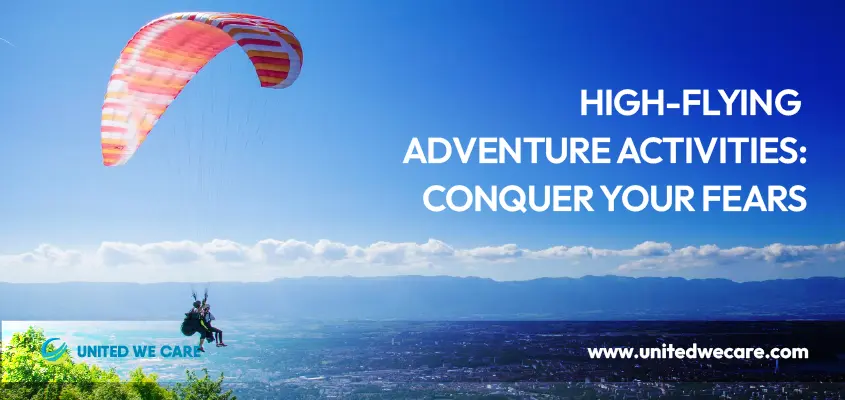Introduction
We, as humans, revel in any opportunity to push past the limits of being “human.” We build gadgets and explore dangerous terrains. We love pushing boundaries and achieving new heights, and high-flying adventure activities bring us all of this and more. These activities make us defy gravity and soar through the skies like birds. They are activities that provide a big adrenaline rush and a chance to conquer the fear of heights. But not everyone’s the same. Some of us want to have this experience yet fear the outcomes. If you have a fear of high-flying activities, this article is going to help you. In this article, we will talk about what this fear is and how you can overcome it.
What is a High-Flying Adventure Activity?
Adventure activities are a unique type of leisure activities that we humans engage in. Here, the risk of the outcome of a mismanaged mistake or accident is most likely death [1]. Yet, these activities bring a sense of excitement and lead to a shoot in that person’s adrenaline production.
High-flying adventure activities are a subset of these risky endeavors. Here, the activities are conducted at a height, and the experience involves some form of aerial pursuit or flying. There are numerous high-flying adventure activities. Some of them include:
- Paragliding: In this, participants launch themselves from elevated locations, such as hills or mountains, and with the help of harnesses and wings, they use air currents to stay in the air for some time.
- Skydiving: Another thrilling activity, skydiving involves jumping out of an aircraft and freefalling through the air before using a parachute.
- Bungee Jumping: This is a daring adventure where individuals jump from a tall structure attached to an elastic cord. The person first experiences freefall and then a rebounding effect of the elastic cord.
- Zip lining: Involves sliding down a suspended cable while wearing a harness. It is usually done in scenic landscapes like forests or over rivers.
- Wing-suit flying: A slightly advanced activity in which participants wear specialized jumpsuits with fabric wings that enable them to glide through the air like birds at a high speed.
Irrespective of the activity, these activities offer individuals an opportunity to push their boundaries, conquer their fears, and experience extraordinary freedom and exhilaration. Humans temporarily gain the ability to be similar to a bird and defy the rules that govern us.
What are the Benefits of Adventure Activities?
Many people in the past believed that extreme sports were a hobby for individuals with unhealthy relationships with fear [1]. Of course, this view has become obsolete now, and many are beginning to recognize that adventure activities may benefit a person in many ways. Some of these benefits include [1] [2] [3]:
Enhanced Thrill and Pleasure: When it comes to adventure, the thrill and risk is itself a reward. Apart from that, engagement in an activity with a clear goal increases a sense of accomplishment and contentment in the individual. In day-to-day life, such excitement and achievement opportunities are low, and thus, adventure activities provide a sense of novelty.
Escape from Boredom and Comfort: It is spontaneous, it is playful, and it is all about the here and now. Everything that is absent in the daily routine of our lives. Adventure sports allow us to push limits and boundaries and break our self-imposed comfort zones. Thus, even though they are short-lived, they can help break the monotony in a person’s life.
Improves Physical and Mental Health: Adventure sports are physically demanding, and many individuals gravitating towards them are more conscious of building physical strength. Further, the sense of relaxation, joy, and achievement these sports entail has a beneficial effect on one’s mental health.
Enhances a Sense of Freedom: Many individuals in extreme sports talk about the freedom this participation brings. When you are up in the sky, you are free from the constraints and responsibilities of daily life. You are free to move physically and free to experience strong emotions like fear and joy. You are even free to shout at the top of your lungs. These expressions are often curbed in daily life, and thus, adventure activities become emancipatory.
Increases Connection with Nature: In studies focusing more on interviews and lived experiences of people who pursue adventure activities, increased connection with nature has been a recurrent finding. Somewhere, we all crave a connection with nature, and when we do connect, it brings us immense peace. Most adventure activities, including high-flying adventure activities, involve being with nature, which eventually increases our well-being when we engage in them.
What Happens When Fear Becomes Extreme?
While fear is common in all adventure sports, some individuals may have phobias that might make these fears extreme. In terms of high-flying adventures, acrophobia, or fear of heights, might cause a person to avoid or even feel threatened by the thoughts of such activities.
Acrophobia is a common disorder in 1 of every 20 individuals [4]. Some researchers have found that apart from the perception of fear, sensory components are also involved in acrophobia [4]. Whatever the cause, the outcome is extreme physical symptoms and discomfort in people when they are at a height.
If you are someone with acrophobia, it may be much more difficult for you to overcome your fears. Yet, you may still wish to experience this “flying”. Collaborating with professionals can help you improve this condition. Therapists use techniques like systematic desensitization and CBT to tackle acrophobia. If you do this, these high-flying adventure activities will induce a much stronger sense of achievement and happiness, as it will mean you have overcome your phobias.
How Do You Overcome Your Fear Of High-Flying Adventure Activity?
While the benefits of high-flying adventure activities are many, fear is definitely an important part that we need to acknowledge. Fear is an essential part of adventure activities. Part of what makes these activities fulfilling is the big difference between the fear you experience before the activity and the relief you experience after it. But if you are someone for whom the fear before is not manageable, here are some tips you can follow [5] [6]:
Accept the Fear
Fear is inevitable. So, instead of fighting with it, give it permission to affect you. The idea is to work with your emotions rather than against them. You can also take the time to reflect on and understand the specific aspects of high-flying activities that trigger fear. By identifying the root causes, you can begin to address them directly.
Gradual exposure
If you are just starting out, then start small. For instance, you can first try bungee jumping on a smaller scale and then go to bigger cliffs. This will slowly build your capacity to experience bigger, more dangerous activities and also increase your trust in both the activity and yourself as you expose yourself to these activities.
Work with Qualified Professionals
Working with a qualified professional instructor or guide specializing in the adventure activity you are interested in is important. They can provide expert guidance, reassurance, and safety measures that will further build your confidence and also address the fear that may be present.
Visualize success
Visualization techniques are techniques of managing stress and anxiety where you imagine yourself to have successfully completed an activity. For example, you imagine yourself landing safely after paragliding, smiling ear to ear, and feeling amazing. Such visualizations strengthen the end goal and highlight for your mind the positive outcomes of an activity. In response, your brain starts to associate positive emotions with these activities and automatically reduces fear or avoidance.
Breathe Through the Activity
Just breathe. Breathing may sound like cliche advice, but actually, it works wonders in calming down the nervous system and reducing physical tension. You can spend some time before the activity practicing deep breaths and grounding in order to relax for the task.
Conclusion
High-flying adventure activities can bring immense joy and happiness to you. But before you reach that stage of bliss, you have to face and tame your fear and anxiety. To do so, you can start by accepting that fear will be there. Then, you can use strategies like visualization, gradual exposure, and help from experts to work your way through the emotion.
If you are struggling with a fear of adventure sports or some phobia like acrophobia, contact the experts at the United We Care app and Website. At United We Care, our team is committed to providing the best solutions for your overall well-being.
References
- E. Brymer and R. Schweitzer, “Extreme sports are good for your health: A phenomenological understanding of fear and anxiety in extreme sport,” Journal of Health Psychology, vol. 18, no. 4, pp. 477–487, 2012. doi:10.1177/1359105312446770
- J. H. Kerr and S. Houge Mackenzie, “Multiple motives for participating in Adventure Sports,” Psychology of Sport and Exercise, vol. 13, no. 5, pp. 649–657, 2012. doi:10.1016/j.psychsport.2012.04.002
- E. Brymer and R. Schweitzer, “The search for freedom in extreme sports: A phenomenological exploration,” Psychology of Sport and Exercise, vol. 14, no. 6, pp. 865–873, 2013. doi:10.1016/j.psychsport.2013.07.004
- C. M. Coelho and G. Wallis, “Deconstructing acrophobia: Physiological and psychological precursors to developing a fear of heights,” Depression and Anxiety, vol. 27, no. 9, pp. 864–870, 2010. doi:10.1002/da.20698
- KreedOn, “How you can overcome your fears of adventure sports?,” LinkedIn, https://www.linkedin.com/pulse/how-you-can-overcome-your-fears-adventure-sports-kreedon (accessed Jun. 20, 2023).
- “10 steps to overcome your fear of Adventure Sports,” Quora, https://flyboyjoyflights.quora.com/10-Steps-to-Overcome-Your-Fear-of-Adventure-Sports (accessed Jun. 20, 2023).









